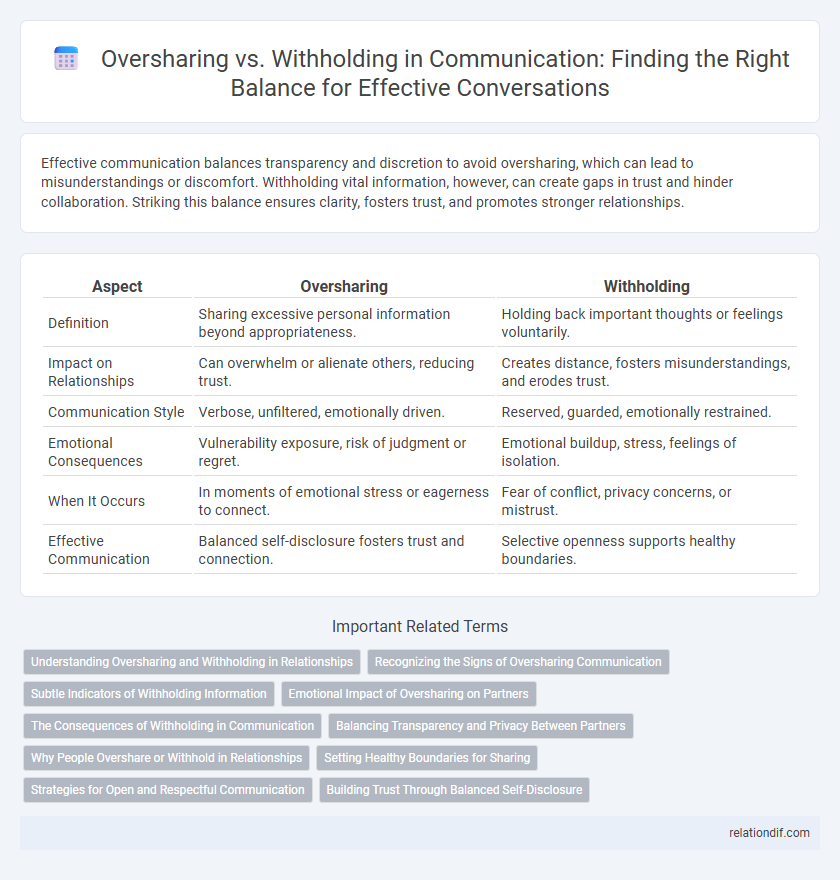Effective communication balances transparency and discretion to avoid oversharing, which can lead to misunderstandings or discomfort. Withholding vital information, however, can create gaps in trust and hinder collaboration. Striking this balance ensures clarity, fosters trust, and promotes stronger relationships.
Table of Comparison
| Aspect | Oversharing | Withholding |
|---|---|---|
| Definition | Sharing excessive personal information beyond appropriateness. | Holding back important thoughts or feelings voluntarily. |
| Impact on Relationships | Can overwhelm or alienate others, reducing trust. | Creates distance, fosters misunderstandings, and erodes trust. |
| Communication Style | Verbose, unfiltered, emotionally driven. | Reserved, guarded, emotionally restrained. |
| Emotional Consequences | Vulnerability exposure, risk of judgment or regret. | Emotional buildup, stress, feelings of isolation. |
| When It Occurs | In moments of emotional stress or eagerness to connect. | Fear of conflict, privacy concerns, or mistrust. |
| Effective Communication | Balanced self-disclosure fosters trust and connection. | Selective openness supports healthy boundaries. |
Understanding Oversharing and Withholding in Relationships
Understanding oversharing in relationships involves recognizing when excessive disclosure creates discomfort or breaches personal boundaries, potentially leading to vulnerability or conflict. Withholding critical emotions or information can hinder trust and intimacy, causing misunderstandings or emotional distance between partners. Balancing transparent communication with appropriate boundaries enhances relationship health and fosters mutual respect.
Recognizing the Signs of Oversharing Communication
Recognizing the signs of oversharing communication involves monitoring excessive personal disclosures that make others uncomfortable or disrupt conversations. Indicators include dominating discussions with irrelevant details, revealing sensitive information prematurely, and ignoring social cues signaling discomfort or disinterest. This awareness helps maintain healthy boundaries and fosters respectful, balanced interactions.
Subtle Indicators of Withholding Information
Subtle indicators of withholding information often include vague responses, inconsistent details, and delayed communication. Nonverbal cues such as avoiding eye contact, closed body language, and minimal engagement further signal reluctance to disclose. Recognizing these patterns enhances clarity and trust in interpersonal and professional communication.
Emotional Impact of Oversharing on Partners
Oversharing can lead to emotional overwhelm and increased stress for partners, often causing feelings of discomfort or burden. Excessive disclosure may blur personal boundaries, fostering resentment and reducing emotional safety in the relationship. Maintaining balanced communication is crucial to preserving trust and emotional well-being between partners.
The Consequences of Withholding in Communication
Withholding critical information in communication can lead to misunderstandings, decreased trust, and weakened relationships in both personal and professional settings. Research shows that suppressing thoughts and feelings increases stress levels and reduces emotional intimacy, impairing effective collaboration and decision-making. Consistent withholding often results in unresolved conflicts and reduced overall communication satisfaction.
Balancing Transparency and Privacy Between Partners
Balancing transparency and privacy between partners requires a mindful approach to communication, ensuring openness without revealing sensitive information that could harm trust. Oversharing can lead to vulnerability and discomfort, while withholding important feelings or facts may create distance and misunderstandings. Effective communication strategies prioritize clear boundaries, mutual respect, and emotional safety to maintain a healthy relationship dynamic.
Why People Overshare or Withhold in Relationships
People overshare in relationships due to a desire for validation, emotional release, or to build intimacy quickly, often driven by insecurity or a need for connection. Conversely, withholding occurs because of fear of vulnerability, mistrust, or past experiences of betrayal, leading individuals to protect themselves from potential emotional harm. These communication patterns significantly impact relationship dynamics, influencing trust, empathy, and emotional closeness.
Setting Healthy Boundaries for Sharing
Setting healthy boundaries for sharing involves balancing openness with discretion to maintain trust and respect in communication. Clearly defining personal limits helps prevent oversharing, which can lead to vulnerability or discomfort, while avoiding withholding ensures meaningful, authentic connections. Effective communication requires understanding when and what to share, fostering emotional safety and mutual understanding.
Strategies for Open and Respectful Communication
Effective communication hinges on balancing openness with discretion to maintain trust and respect. Employ active listening, clear boundaries, and empathetic responses to foster mutual understanding while preventing oversharing or withholding vital information. Transparent dialogue paired with respectful feedback encourages an environment where individuals feel valued and heard.
Building Trust Through Balanced Self-Disclosure
Balanced self-disclosure fosters trust by sharing personal information thoughtfully without overwhelming or withholding crucial details, allowing genuine connections to form. Oversharing can create discomfort or vulnerability, while excessive withholding may generate suspicion or distance in relationships. Effective communication requires understanding boundaries and tailoring openness to build mutual respect and emotional safety.
Oversharing vs Withholding Infographic

 relationdif.com
relationdif.com